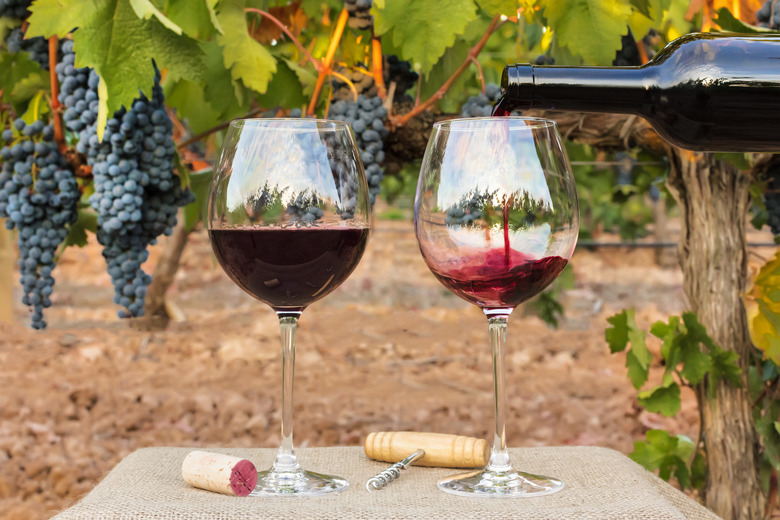An Introduction To Reasonably Priced Bordeaux Reds
Bordeaux: It's all about the blend. Whether your palate preferences steer towards reds or whites, the best wines of Bordeaux lean heavily on a synergistic blend of grape varieties. Red grapes are king, with the region's renowned red wines accounting for close to 90 percent of Bordeaux production.
While many hear the word "Bordeaux" and think high-end first growths, the happy truth is that the region offers a consumer-friendly range of wines remarkable in quality, style, pricing, and availability.
As one of the wine world's oldest, largest, and most famous wine-growing regions, Bordeaux can appear complicated at first glance. We've pared it down to the basics — the lay of the land, the key grapes to know, and a few specific wine recommendations to get your journey into Bordeaux jump-started.
Navigating this famous wine mecca, tucked into the southwestern corner of France, requires a bit of geography. It's mission-critical to keep in mind that place names and not grape names are of primary importance when buying Bordeaux. You won't find the New World's consumer-friendly practice of pasting grape names on every bottle. There's no "Cabernet Sauvignon" or "Merlot" front and center on Bordeaux bottles; instead, there are regional clues, which will give you a heads-up about which grapes may dominate the mix.
Clue No. 1: A river runs through it. And this river is very, very important. It has a name, the Gironde. Technically an estuary, the Gironde splits Bordeaux right down the middle, creating the region's hallmark nicknames of Right Bank and Left Bank — to the north and the south, respectively, of the Gironde and its tributaries. Both sides contain many villages, vineyards, and vintners, and as a consumer, it's helpful to know which appellations or villages lie on which banks, because it's the appellation or village name that typically appears on the bottle label.
Clue No. 2: Bordeaux's red wines are typically a blend of up to five designated grapes: merlot, cabernet sauvignon, cabernet franc, malbec, and petit verdot — though in practice it's the first three grapes that do the heavy lifting for the region's reds. As a broad generalization, merlot dominates the vineyards of the Right Bank and cabernet sauvignon digs deep into the gravel-based soils of the Left Bank (though delicious exceptions exist on both banks).
Merlot is an early-ripening grape, while cabernet sauvignon tends to demand more hang time on the vine. With Bordeaux's proximity to the Atlantic, wild maritime weather patterns may impact an entire harvest via frost, hail, or too much or too little rainfall, though in any given season one side of the river — or grape variety — may be partially shielded from major weather effects, depending on the location or the stage of the grape's maturity.
Even more significant is what the individual grape varieties bring to the blend. Merlot, Bordeaux's most widely planted grape, shows the softer side of the region, with moderate tannins and lower acidity, higher alcohol, cherry-driven profiles, and rich textures. Cabernet sauvignon brings higher tannins (and longer aging ability), more acidity, and lower alcohol levels, along with classic black fruit character. When combined, the two grapes make a magnificent marriage, each partner complementing the strengths and potential weaknesses of the other; what one may lack, the other fills in, working to bring balance to the blend.
Good to Know: Bordeaux's merlot-based blends tend to be more approachable at a younger age, while the cabernet sauvignon-based ones show greater aging potential in the long run. However, the region's wines in the under-$30 category are typically ready to roll upon release — though locals would say that we drink their wines much too young and that they'd benefit from at least a year or two of aging.
Most Bordeaux is labelled as either Bordeaux AOC or Bordeaux Supérieur AOC (carrying tighter restrictions) indicating that the grapes may be sourced from all over the region, unless a qualifier like "Castillon" or "Francs" is added.
Bordeaux Red Wines to Try:
Château Hyot Castillon Côtes de Bordeaux 2014 ($15). This Right Bank blend is 70 percent merlot, 20 percent cabernet franc, and 10 percent cabernet sauvignon. With ripe black fruit character and well-integrated tannins, it shows a clean, food-friendly finish.
Château Sénéjac 2014 ($17). Representing a very classic version of Bordeaux, with firm tannins, black fruit, and spicy extracts, this dark-pigmented Left Bank wine is deeply concentrated, and the bottle delivers considerable bang for the buck.
Château Puygueraud Francs Côtes de Bordeaux 2014 ($18). Bright berry flavors shine a snappy spotlight here on tangy acidity and well-woven tannins. Château Puygueraud promises a fun, fresh introduction to the happening region of Côtes de Bordeaux.
Château d'Agassac 2014 ($20). This budget-friendly blend out of the Left Bank's Haut-Médoc pays homage to the earth with an unmistakable minerality, engaging eucalyptus nuances, and remarkable intensity.
Château Peymouton 2012 ($22). A Right Bank blend from Saint-Émilion, combining 65 percent merlot, 25 percent cabernet franc, and 10 percent cabernet sauvignon. Expect plenty of juicy black fruit to be front and center, leaning heavily into blackberry, plum, and blackcurrant, with fresh acidity and sweet tannins lending decided structure, and a lovely, lingering finish.
Château Labégorce 2014 ($28). Hailing from Margaux, this bottle consists of 58 percent merlot, 40 percent cabernet sauvignon, and 2 percent petit verdot. Highly aromatic, with a heady mix of fruit and smoke, this medium-bodied wine highlights firm tannins and generous acidity.
